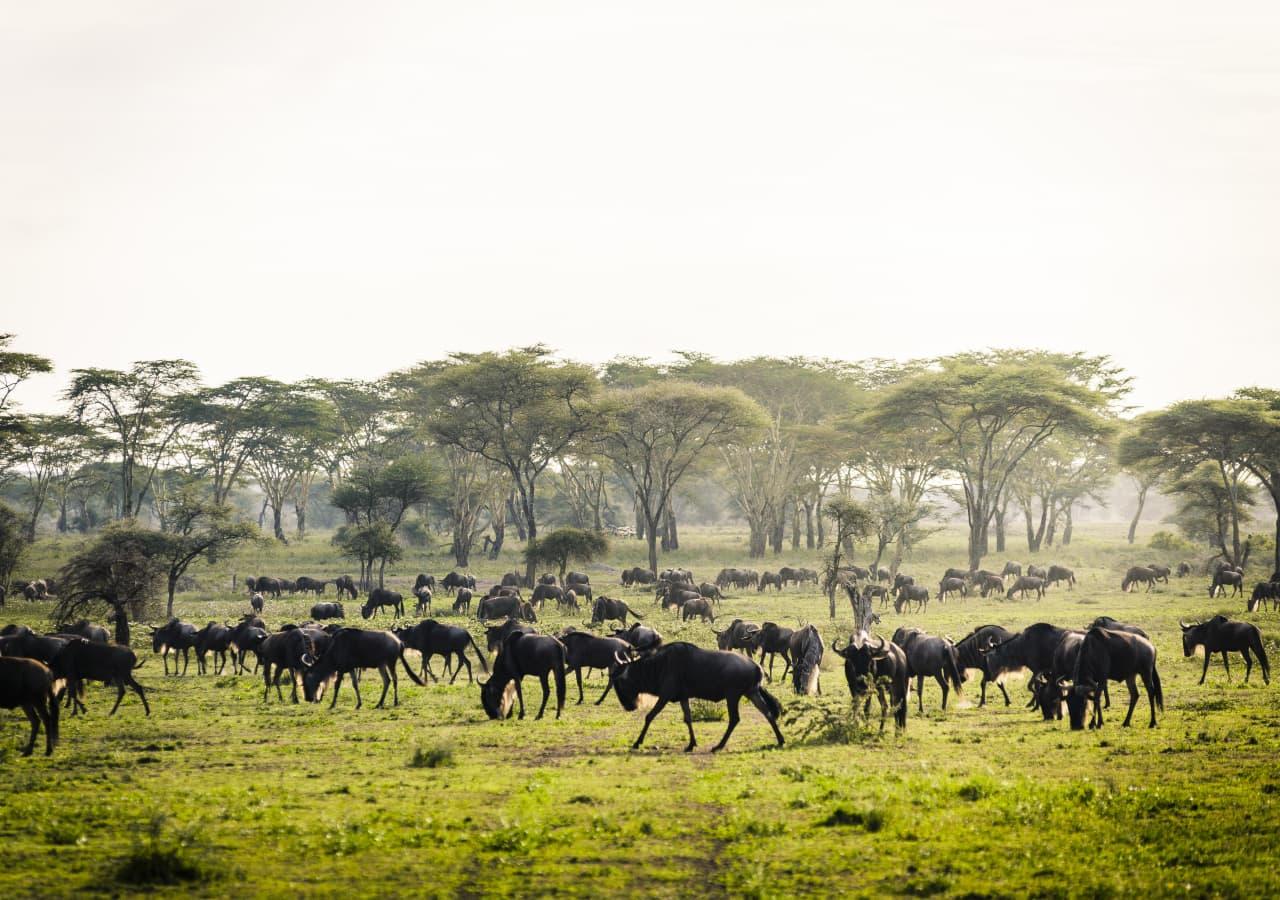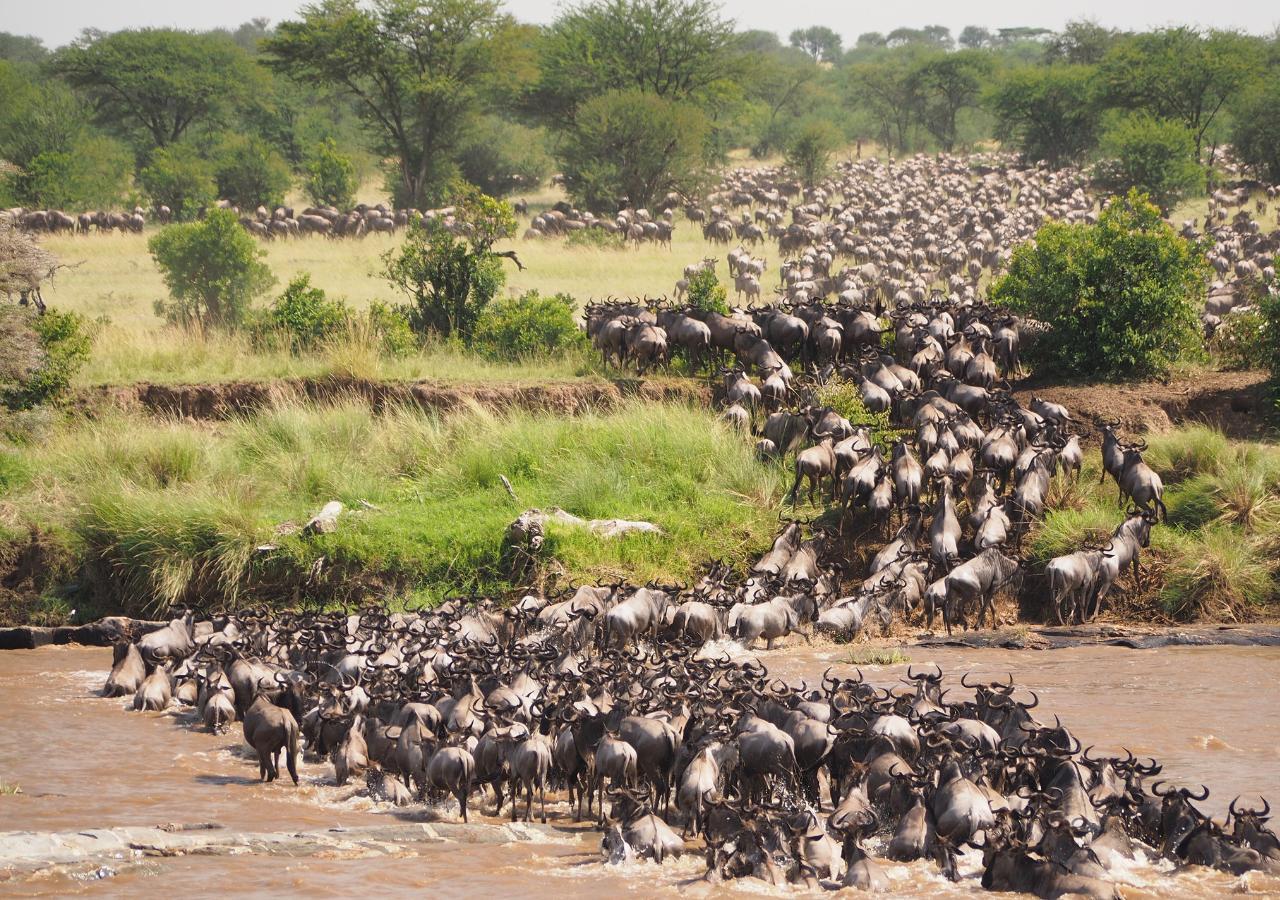If you're planning to embark on an awe-inspiring journey to Tanzania or Kenya to witness The Great Wildebeest Migration, it's not always as easy as just showing up. Following a year-round, circular path, the migration is an endlessly active phenomenon that cannot be predicted with complete certainty. As the animals move in constant search of food and water, the timing of their journey is entirely dependent on ever-changing weather patterns, such as rainfall, and other environmental factors.
The good news is that because this is a year-round spectacle, each season offers its own highlights. Drawing from their on-the-ground expertise, our Travel Experts have put together an estimated guideline for where you can expect to find the moving herd throughout the year (alongside a little bit of magic and a touch of luck!). For more information, you can also read our blog on The Wildebeest Migration Explained.

January to March: Calving Season (Serengeti)
January through early March is an exciting time to witness the mega-herd congregating for calving season in the fertile Ndutu plains, in the Ngorongoro Conservation Area to the southeast of the Serengeti National Park. This is the season when the wildebeest calves are born over a period of 3 to 5 weeks, making it one of the most popular times to visit. With up to 8000 newborns per day, predators like lions and hyenas stick around to hunt the vulnerable young wildebeest. Brace yourself for some heart-stopping sightings as Ndutu becomes a battleground for survival.
Fortunately, because so many calves are born in such a short period, the predators do not have enough time to eat them all. Long rains are expected to arrive towards the end of March, causing the grounds to become muddy. The mega-herd and their offspring are now ready to journey north.
April to May: Migrating North (Serengeti)
To witness the wildebeest migration in April or May, you can follow the herds as they move from the depleted southern plains to the long grass plains and woodlands of the Serengeti’s western corridor, almost to Lake Victoria. This is the height of the rainy season. It may not be the most comfortable time to visit, but the low season rates can be very appealing. The lush green landscape and beautiful scenery are a sight to behold.

June to July: Rutting Season & River Crossings (Serengeti & Maasai Mara)
As June arrives, the migrating herd splits into two columns. One group heads west to Lake Victoria, another passing north through the northern Lobo area of the Serengeti. Large groups of wildebeest can be seen on the southern banks of the Grumeti River in the Western Serengeti, ready to face their first hurdle of crossing crocodile-infested waters. Rain and herd unpredictability makes this season tough for safari-goers. But if you're lucky enough to catch a herd in June, get ready for the exciting rutting season! Male wildebeest clash horns to secure prime spots around watering holes, attracting females for an unforgettable wildlife spectacle.
Get ready for the thrilling main event which usually approaches around July. As the herds move and eventually gather along the Mara River, anticipation builds as they prepare to cross this second and final barrier to reaching the short, sweet grasses of the Maasai Mara. To increase your chances of witnessing a river crossing, you should be in either the Serengeti's western corridor or its northern reaches. However, in some years, the Kenyan side may offer better views. Keep in mind that the timing and duration of the river crossing are unpredictable, and few wildebeest may actually cross the Mara River into Kenya in years with little rainfall.
For the thousands of wildebeest who do decide to hurl themselves into the unforgiving waters, they face the danger of lurking crocodiles who lie in wait. This heart-stopping event unfolds over several days, as the herds surge back and forth across the Mara River.

August to October: Grazing Glory (Maasai Mara)
By the end of August, the courageous survivors who have made it through this epic journey will be rewarded with lush grazing lands in Kenya's Maasai Mara. However, in some years, a significant portion of the herds remain in the north of the Serengeti. In such cases, it is recommended to base yourself in the northern reaches of the park, known as the Lobo area, to have a better chance of seeing the migration during these months.
During this time the wildebeest are all in search of fresh grazing lands and water, creating a predator's paradise: before the "short rains" arrive, the wildebeest huddle around scarce watering holes, making them easy to spot. This makes for epic battles and great game viewing. As October approaches and the dry season draws to a close, the wildebeest's thoughts turn to migrating once again.

November to December:
The "short rains" in Tanzania begin in November, breathing new life into the Serengeti's short-grass plains and enticing the wildebeest to graze. The herds are summoned south across the Tanzanian border and move through Loliondo and the Serengeti’s Lobo area, finally reaching the grazing paradise of the southern Serengeti. By December, the wildebeest are typically scattered across the eastern and southern plains of the Serengeti once again. The cycle continues as the calving season arrives once again.




